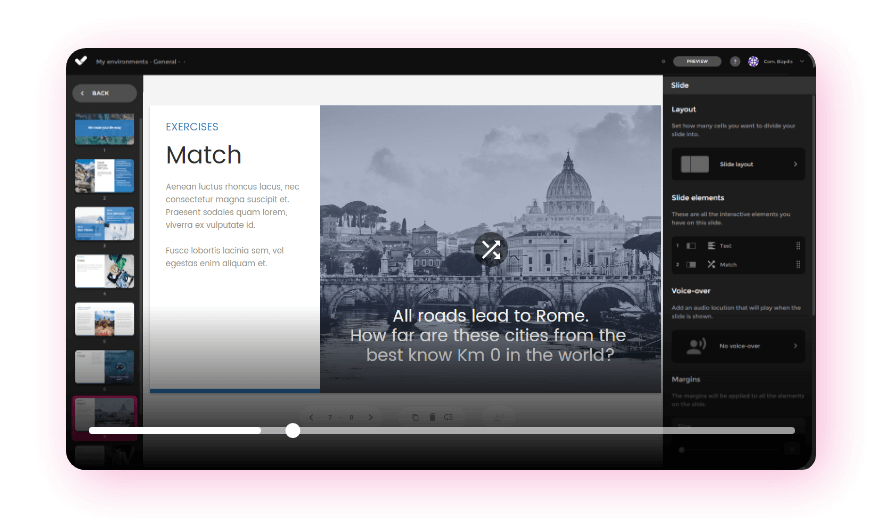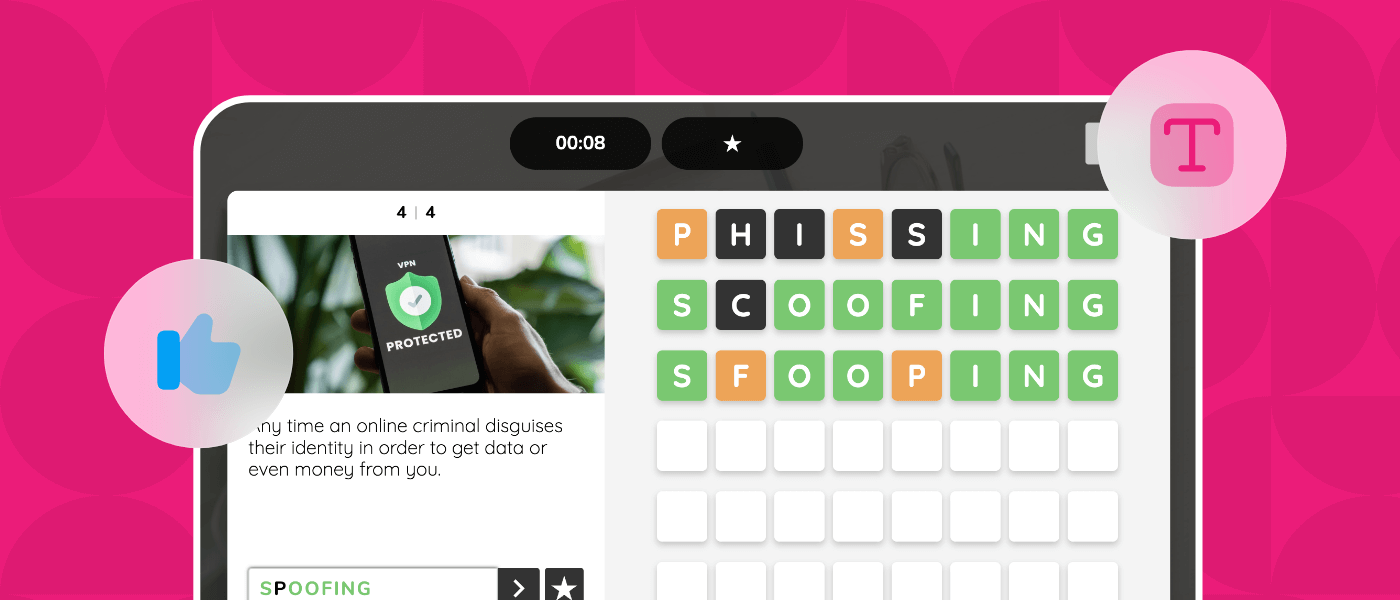
WEBINAR ONDEMAND
How AI can become your main ally in creating your e-learning courses
October 2, 2024

Table of contents
Starting a new project is always an exciting opportunity, although sometimes taking that first step can seem like a big challenge. The key to overcoming this issue is proper planning, which will give you control, clarity and a more coherent vision of what you want to achieve. Put simply, every great project must begin with a solid structure.
In the world of e-learning, this rule is no different. Each course should start life with a well-defined planning document, or guide, that allows you to organize content, define the different steps in the learning experience, and create an overall effective training experience. This initial structure is known as a course outline, and mastering its development is the first step to creating a successful online course. Are you ready to learn how to do it? In this article, we’ll walk you through the whole process.
A course outline is essentially a complete course plan or structure. It is a vital planning tool which brings together key information such as learning objectives, activities, materials, evaluation methods and more, tying them together to form the basic structure of the course.
The outline acts as a roadmap that links content, tools, and learning outcomes. Developing one will not only help you, as an author, to construct a more effective course, but also help learners to better understand what they can expect from your course and how it will benefit them.
With a clear outline, you can ensure that you avoid unnecessary delays or stalls in the creation of your courses. In addition, you can use it to prevent yourself from deviating from your main objectives, and to promote your content with students. This way, both parties will know exactly what topics, activities, resources, and objectives the training covers and, most importantly, you’ll have a solid framework on which to build your course.
The answer is simple – because for students, it sets clear expectations, and this transparency is key to increasing motivation and participation.
Although you may already have an idea of what you want to achieve with your course, it’s crucial to organize these intentions in a structured way. To help you do this, we’ll go through the key elements that any good course outline should include:
These are the specific goals that you want students to achieve through your course. Defining learning objectives will help you guide the development of the content as well align it with student expectations. Learning objectives should clearly define what students will be able to accomplish by the end of the course, and so they should be specific, measurable, achievable and time-limited.
Breaking down the content you plan to include will give you the basic structure of your course. You’ll end up with a series of modules or units and, depending on the length and complexity of the course, the appropriate amount of content for each one. This structure should follow a logical progression of the topics in play, and should also be clear enough to ensure that students have a clear overview of what they will be learning at each stage.
A complete course outline should also include the methods you intend to use to assess students. Will they be quizzes, assignments, coursework projects, or ongoing assessments? Give an indication of this in your outline to provide students with measurable objectives and outcomes.

Finally, don’t forget to include a list of all the materials and resources that students will have access to throughout the course. This includes readings, guides, audiovisual content, tools or software, or any complementary external resources.
Top tip: Choose (or create) materials that reinforce the information covered in your course, and that help students achieve the proposed objectives.
Now you have all the information you need to form your course outline at your fingertips. So, it’s time to get down to business:
You’ve created a course to help a specific audience achieve a set of defined objectives. But who are these people? The better you know your intended audience, the better the learning experiences you can create.
Remember that your audience’s desired objectives, level of knowledge, and even weak points will all have a significant impact on their learning. You can accurately collect this information by carrying out a simple survey, and thereby offer a more personalized experience that meets student expectations.
We’ve already covered what learning objectives are. Now, it’s time to write them down. The best way to do this is to simply put into words exactly what you want your students to learn. For example, if you’re creating a course on social skills, your learning objectives might look like a little like this:
“What will you be able to do after this course?
Now you need to divide your course into distinct learning modules. When doing this, keep in mind that less can sometimes be more. By breaking your course down into a number of short, easy-to-digest modules, you’ll ensure that you keep your students engaged and motivated throughout. What’s more, following this advice will allow you to create the backbone of your course, resulting in a series of topics and subtopics that you plan to cover at each stage.
At this point, you should start thinking about the activities you want to include in your course. These should respond appropriately to your learning objectives and reinforce your content. Avoid cognitive overload by integrating learning resources that truly add value, instead of simply taking up space. You can add quizzes, games, videos, interactive videos, and many other types of resources that will help students engage more deeply in their learning.
Don’t forget to add assessments to your courses. Quizzes can help students refresh their knowledge, and put their learning into practice. Self-assessments are ideal for prompting students to reflect on their learning journey and find new ways to improve, while ongoing assignments, projects and final tests help to accurately measure students’ knowledge levels.
By following these steps, you’ll be able to design a clear course outline that will help you create spectacular courses. And, if you need further help creating your courses, then check out our complete guide to creating and selling online courses.

So far, we’ve seen how easy it is to create a course outline. However, it’s easy to make some key mistakes when designing your outline that could potentially affect the quality of the course, as well as the student experience. Here are some of the most common that you should seek to avoid:
If your learning objectives are not clearly defined from the beginning, then students will lack a proper understanding of what they should achieve by the end of the course. This can lead to demotivation and confusion.
It can often be tempting to include too much information within a course, but instead of being beneficial, this can seriously overwhelm students. So, instead of covering a wide range of topics in a superficial way, try prioritizing those that are most relevant, and emphasize them.
Another typical mistake is wanting to design a course without taking the specific profile of the audience you are targeting into account. Each group of students has a different level of knowledge and specific learning needs, and by not taking these into account you could end up with a course that is either too basic or too advanced for them.
Your students should feel sufficiently challenged throughout the course, because this allows them to measure the progress of their learning and motivates them to continue. Therefore, you should strategically distribute assessments to test students throughout the duration of the course.

Now that you know all the essential elements involved in developing a course outline, it’s time to start creating your own courses. And, if you’re looking for an easy and agile way to achieve this, then isEazy Author is the perfect tool for you. Take advantage of an authoring tool designed to quickly and autonomously create attractive, effective e-learning courses – and all without the need for previous experience. Request a demo today, and start creating spectacular courses in just a few minutes.
A course outline should include a number of key elements, such as learning objectives, a breakdown of course content, the assessment methods you intend to use, and any required resources and materials. When combined, each component will help you to establish a clear and organized structure, ensuring that both instructor and students understand exactly what the course will cover. With isEazy Author, you can easily build each of these elements into a solid structure using our intuitive platform.
In order to start creating a course outline, you first need to define your learning objectives, and think about what type of content you want to include. Then, begin organizing that content into modules or units, before determining which assessment methods you will use. If you’re looking for a tool to make this process easier for you, then isEazy Author offers a range of templates and features to help you create a well-structured outline for your courses.
A training course outline is usually geared toward practical skills that can be immediately applied in the workplace, while an academic course outline tends to focus more closely on theory and conceptual knowledge. Both types of outlines, however, will benefit from a clear, well-defined structure. isEazy Author is versatile enough to adapt to both styles, allowing you to create the outline that best suits your needs.
Yes, there are templates that can help you create an effective course in just a few minutes. With isEazy Author, you’ll have access to a range of templates that streamline and simplify this task; all you need to do is choose the slide structure that suits you best, arrange its elements, customize, add interactive and multimedia elements, and that’s it! Plus, with its artificial intelligence features, you can multiply your productivity by adding subtitles and automatic voiceovers, translating your entire project and generating final assessments in seconds. And now, you can even add training videos complete with AI-generated avatars, in no time at all.
Yes, a well-structured course outline can improve learner engagement by acting as a clear roadmap of course expectations. This clarity helps learners to chart their progress and stay motivated.
It’s recommended that you review and update your course outline periodically, especially if you’re aware of any important changes that need to be made concerning course content, learner needs, or learning objectives. The flexibility of isEazy Author allows you to make these adjustments easily – you can duplicate projects, slides and interactive elements, and update content whenever you want, ensuring that your course is always aligned with current standards.
Create e-learning courses 3 times faster
Discover the No.1 authoring tool on the market
Try it freeRequest a demo



